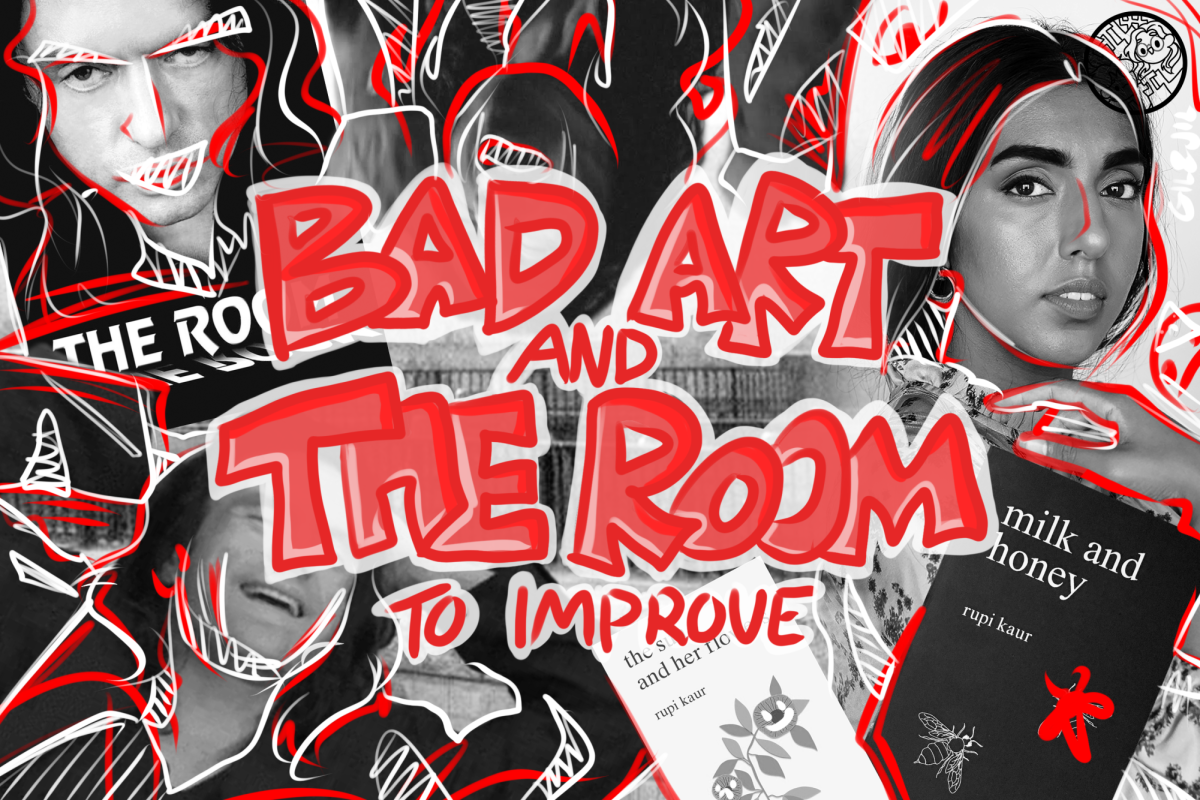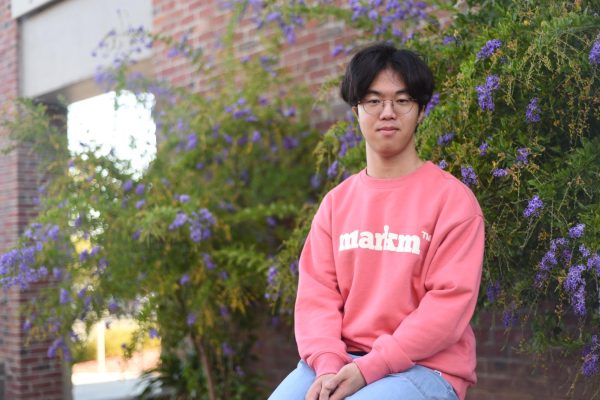TW: You’re tearing me apart, Lisa!
GL & JJ: Oh, hi audience.
JJ: What you just heard was the most iconic line from the 2003 independent film “The Room,” produced and starred by Tommy Wiseau. It follows Johnny, a struggling banker, and his relationship with his fiancee, Lisa. And Lisa is indeed tearing their life apart. In fact, that’s pretty much all she does.
GL: The film quickly gained status as one of the best “so bad it’s strangely good” movies for its horrible editing, wonky characters and general iMovie qualities. Tom Bissell, who literally co-wrote the book on “The Room,” titled “The Disaster Artist,” said the following about it in a Vox video:
TB: It is like a movie made by an alien who has never seen a movie, but has had movies thoroughly explained to him.
GL: And that’s one thing to hear about it, but it’s another thing to watch. It’s an experience for sure. Here’s another clip from the climax of the movie, where Johnny discovers Lisa has been cheating:
TW: You betrayed me! You not good. You- you just a chicken chip chip chip chip cheep cheep!
JJ: And we did experience it. In fact, we experienced it a few months ago, in June, before we went to see Ocean Vuong, actually, so that was amazing contrast between artists. And it was completely astounding, the way Tommy Wiseau does not know how human interactions work. Every single thing he writes is very, very alien indeed. And it’s just extremely strange because Lisa is the most confusing, but also, her characterization makes a lot of sense in the context of what Wiseau is trying to go for. But essentially, she’s this very one sided villain, and she’s sexualized a lot. There are at least three sex scenes involving her, probably more, and every single character in the movie comments on how pretty she is. And the whole thing is kind of like, there’s this guy, and he’s perfect. He may not be perfect, perfect, but he’s trying his best, but his girlfriend is just so intent on destroying him. And watching that very skewed perspective was definitely something.
GL: In that sense, it’s kind of a meta take on why relationships fall apart. You can see in the movie that Tommy Wiseau does not understand human relationships, or does not have the self awareness to know the nuances of the reasons for a relationship not working out. We said this already, but it’s really bad. But it’s sincere at least. And because it’s sincere, it is able to have a message even if the message was unintentional. If it wasn’t even sincere, then it would just be bad without any message at all intentional and unintentional. And the fact that the writing itself for this film is so one sided and doesn’t show the dimensions of a relationship – it kind of illustrates why the relationship fell apart, right. And it shows the barriers that he has in understanding that can cause us breakups, and has most likely caused the breakup that he uses as inspiration for this movie.
JJ: So essentially, because he doesn’t understand why breakups happen, and because he’s so dedicated to portraying characters as realistic people with realistic behavior, but still can’t bring himself to give Lisa an actual character arc– this says a lot, and it’s actually like pretty jarring to see a movie with such blatantly bad content actually say something about the nature of relationships. And that kind of got us thinking about the art we make and the focus on quality that’s often attached to that kind of art. Especially in Monta Vista, there’s this really high bar for quality or there’s a strong priority on competitions or external motivations instead of writing or creating what you want to.
GL: This got us thinking about “oppression poetry,” which is like poetry about race, feminism, and such topics, but it doesn’t really say much on the topic. It feels revolutionary, but in reality, it’s just a repackaging of common messaging that we see everyday. And it, in some cases, makes it impossible to critique properly because it is so reliant on the fact that it is “morally right” that there seems to be no need for actual substance to it. A great example of this oppression poetry is Rupi Kaur. Rupi Kaur’s debut poetry collection “Milk and Honey” has sold, according to Wikipedia, which we all know is a very reputable source, over 3 million copies, and it’s been on the New York Times bestseller list for 165 weeks, possibly even more. She’s very popular. And this is an excerpt from one of her poetry collections:
RK: Don’t mistake salt for sugar. If he wants to be with you, he will. It’s that simple.
JJ: I think the brevity is part of what actually makes it work, in the sense that it gives you so little that you’re forced to fill everything else in by yourself. First sentence: “don’t mistake salt for sugar,” just like general advice, right? Obviously, like she’s getting it like, ‘oh, you know, it’s sometimes a bad thing, but it looks like a good thing. And people be like that, sometimes. That’s my advice to you.’ In the second part, it just kind of jumps in the sense that she doesn’t develop that salt or sugar metaphor, because she doesn’t need to, because it’s very simple, because it’s the kind of thing you would easily latch on to, especially knowing her work. So the second line, “if he wants to be with you, he will, it’s that simple.” That obviously cements the theme of relationships. So you’re like, okay, yeah, this is talking about relationships, you know, if it looks bad, or if it looks good, maybe it’s bad, or the other way around, depending. I think just like the fact that she relies on these stereotypes, and these tropes to the point where you can fill in the rest of the context, you don’t need that much detail at all to really know what she’s going for, because it’s just not necessary. And for good poets that’s achieved through good imagery, through describing very specific details that are just strong enough to really evoke that image while not being that overbearing. That kind of imagery– usually, that’s where the simplicity comes from. Usually, that’s where it’s like: one image, that’s it, you got the whole scene. But with this: one image, you got the whole scene, because you’ve seen the scene a million times before.
GL: Well, I think, first of all, there is a definite lack in technical skill that she displays, or at least, there’s a lack in poetic conventions that she follows. And it’s not defying them to prove a point really, in our opinion. She just doesn’t put in the effort to use this poetry techniques to deepen her messages, right? Some poets do go against common poetic norms, but they do it after learning how to use the norms that they are breaking, after using them, experimenting with them, and ultimately, realizing that active and aware defiance proves their point and conveys the message in itself. But Rupi Kaur does not do that.
JJ: And I think another point of contention is among the artists community themselves. I know that there’s a strong sense of deservance, injustice, obviously, not just within the art community, but especially in a place where people feel like they have to fight to have the right to have their work showcased. And what I see in a lot of these forums– for example, I follow this one book YouTuber, he covers these like atrociously bad books, like not bad, where it’s like, okay, some people like it, some people don’t — it’s objectively, like, the worst books that have been published. And what I see in a lot of the comments is like, oh, “Seeing this get published, and as like a writer myself, I feel like that gives me a lot of confidence. That makes me feel like, if this can get published, so can I!” And I feel like that’s the kind of idea that extends to how artists perceive Rupi Kaur when they see her have so much success, and they see her really thrive on this platform for work that maybe doesn’t feel like it lives up to a standard that they’re holding themselves to. It can feel really unfair. And, you know, obviously, it’s different for everyone. Art really shouldn’t be a competition. But when it’s such a cutthroat industry, when there’s like so many people, and it’s so saturated, and everyone’s trying to grapple for attention, especially on platforms like Instagram, you can definitely feel bitter towards these people who have such a large audience for comparatively worse work. And even though quality isn’t necessarily objective, that can feel bad when you’re developing as an artist because it feels like you’re trying in the wrong direction, or that there’s just something inherent about your work that isn’t getting somewhere. So I think that’s an important part of why people don’t like her.
GL: At Monta Vista, students very much focus on colleges, they worry about what specs that they’re gonna put on their college applications, you know, their extracurriculars, awards. Monta Vista is a very STEM-oriented school. It’s hard enough being a humanities or a more art-focused person here. And the interest in the arts and humanities combined with Monta Vista’s mindset of competitiveness and concentration on quantitative data leads to perhaps this sense of creating art simply for the sake of winning awards, for more quantitative data to be put onto your college application. And I’ve definitely felt this with my poetry as well, even if it’s bad. And we just think that this kind of environment is not really helpful for people wanting to grow as an artist, because it’s very hard to be good in high school, but you’re giving it a shot right and you need to be bad and cringe-worthy in order to have a chance of perhaps being okayish in the future. And if we’re so focused on winning awards, then we could end not being so genuine and writing about topics that have shown to be more award-friendly, or topics that we hear about a lot in media and aren’t really offering a new nuanced perspective on it, but rather rephrasing the common belief in fancy flowery language.
JJ: I think it’s that these topics and these concepts have become so inextricably linked, there has been kind of a feedback loop where students understand that poetry that deals with these topics, such as race and feminism — just to name two of them, obviously, they’re a lot more — poetry that deals with these topics, students have seen how they perform. And again, it ties into perceiving other people’s work, right? So just like in the YouTube forums, where some people would feel like their work wasn’t getting the attention it deserved, even though there is comparatively worse content out there, it’s kind of the same concept with Monta Vista, and with poetry and contests in particular. Because you’re looking at this, and you’re thinking, “Okay, this is a poem about like this topic. But it feels like they’re holding themselves to a standard that is different from mine.” And again, that speaks to kind of the toxic, competitive culture of Monta Vista. But when all that comes together, when all of these factors become dependent on each other, it creates a mindset where you’re no longer focused on art for the sake of art, or even experiencing other people’s art for the sake of their art. I think it makes you lose appreciation for what you’re doing, because you become so consumed. Again, especially when it’s so competitive, especially STEM, but it extends to humanities. When it’s so competitive, it’s hard to find your place in that kind of culture. And it’s hard to talk about what you want to talk about without making it seem like it’s taking away from what you should be doing or what’s most efficient for you to put on an application. So, at the end of the day, there’s something to be said about making art for yourself, or even making art that isn’t up to your quality standards just because you want to and you want to try to go for that. I think that’s really kind of a mindset change that could benefit a lot of people here. And obviously, it’s not that easy, right? But we can always strive to just have a little bit more of that in our day, because you can spare like 10 minutes to do something you like, and I think that’s really cool.
GL: Ultimately, perhaps we are a little too harsh on Rupi Kaur.
JJ: And in that sense, Rupi Kaur was able to convey something to people in the same way “The Room” conveyed something to people. And while there are many, many people who think that both are objectively bad artists, that kind of art still changes the lives of those who are in their audience. And at the end of the day, whether or not these artists intended that message or even have the skill to deepen those messages is irrelevant. You’re experiencing the art, and those experiences will be different for everyone. It’s just very interesting to us that this chaotic man is trying to talk about every issue under the sun– he brings up drugs, he brings up alcoholism, he’s trying so hard. But in that chaos, you can find that actually very potent message, and you can get the sense that this message arises organically, as a result of his own emotions and biases, not because he intended to wow people. In fact, he later went on to make another movie: “Big Shark,” released in April of this year. But that movie didn’t get the same response because people could tell that this was Wiseau trying to make a purposely bad movie. Despite being a mess, “The Room” stuck in people’s minds for a long time because of how raw it felt, regardless of the quality. So I just think as artists ourselves, what we’re realizing is that that’s kind of aspirational, right? We want to and we should strive to grow our skills, but the fact that our work comes from a personal place is what makes it genuine, and what makes it last the test of time potentially.
GL: Yeah, and we’re not saying we’re like really good poets. We haven’t mastered the form, obviously. We’re in high school. We don’t know anything. But at the very least, we are genuine, right? And at the very least, we strive to improve our skills. And perhaps that’s the most important thing when it comes to creating art. The purpose of art is not performative, but rather it’s this genuine earnestness, and I feel like that should be the purpose of the art that we create, even if we are in a community that prioritizes something else over that. And when we consume art that is objectively bad, we should still at least appreciate it or give it a second chance because we should keep in mind that, most likely, this art was created by someone who, while they lack technical skills, they were earnest and they were emotional with this art. And that in itself is is a huge accomplishment and that deserves to be respected.












